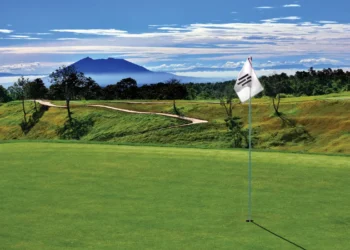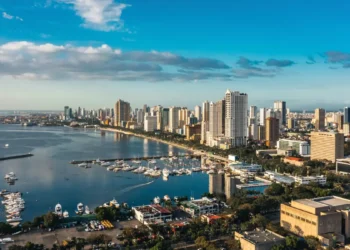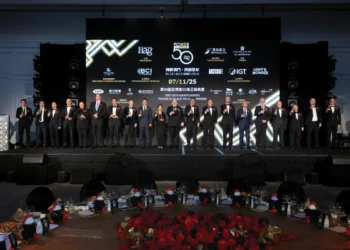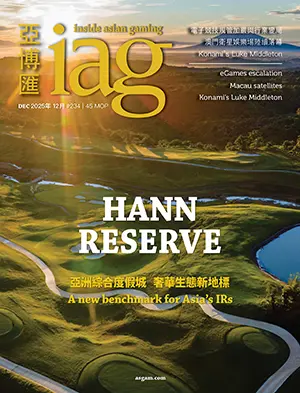Inside Asian Gaming’s rundown on the destinations competing for a place at gaming’s top table alongside Macau and Singapore
There are currently six Asian jurisdictions jockeying for the number three spot in international investors’ affections when it comes to building fresh regional markets for resort-style casino gaming.
The leader in the foot race behind Macau and Singapore is ostensibly the Philippines. It already has an integrated resort (IR) complete with gaming, multiple hotel brands and meetings, incentives, conference and exhibition (MICE) facilities. That’s Resorts World Manila—conveniently situated across the road from the capital’s international airport. Even better, one of the partners in this joint venture is an internationally-proven casino operator—Malaysia’s Genting Berhad via its Genting Hong Kong unit.
International investors can already gain equity exposure to that property. It’s a US$700 million, 50:50 joint venture between two listed companies—Genting Hong Kong (quoted on the Singapore market) and Philippines developer Alliance Global Group (listed on the Manila exchange). Genting Hong Kong—formerly known as Star Cruises—also operates casino cruise ships out of Hong Kong and other ports in the Asia Pacific region. Other potential Philippines IR opportunities are on the horizon for international investors. A joint venture IR—Belle Grande Manila Bay between local companies Leisure and Resorts World Corp and Belle Corp, and with a reported price tag of US$750 million—is currently under construction in Manila. A third resort—possibly with investment from Aruze Corp, the gaming company founded by pachinko machine maker and Wynn Resorts Vice Chairman Kazuo Okada—has also been proposed for the Manila Bay area.
Contenders
The Philippines market is not yet as big in gross gaming revenue (GGR) as South Korea however, which is worth about US$2 billion per year; about half of that supplied by the one casino (located out in the boondocks) that’s allowed to serve local players. South Korea is making noises about a major overhaul and liberalisation of its casino regulations that would allow for at least one more casino serving locals and up to five international-standard IRs.
For any of the aspiring Asian jurisdictions to take and then hold on to the third spot for investor appeal behind Macau and Singapore, they will need to compete not only in terms of GGR but in terms of regional attraction to consumers and in terms of rate of return on investment for the backers. On those points what matters is not simply who is first to put something up. What counts for a sustainable IR industry is who has the best transport infrastructure, the best quality of execution and management, and the most transparent regulatory and governmental system—including competitive tax rates. When judged by those criteria, other jurisdictions that haven’t yet completed IRs but are on the road to doing so—or are talking a good game on the topic—must be taken as serious contenders.
Vietnam already has its first IR project well underway with an opening due in the first half of 2013. Its first phase investment costing US$430 million is only one thirteenth of what was spent on MBS alone, although the Vietnam scheme is officially slated ultimately to be a US$4.2 billion multi-phase and multi-branded project. The differential in capital spend on IRs in Singapore and Vietnam is not surprising given the earlier stage of social and economic development Vietnam is in compared to Singapore and its neighbours Malaysia and Indonesia. And Vietnamese aren’t currently allowed to gamble in the country’s casinos—unless they are one of the 3.7 million ‘Overseas Vietnamese’ with access to a foreign passport.
But like the Singapore IRs and Resorts World Manila, the Vietnam project is backed by the brand power and marketing support of a major international operator—in this case MGM Resorts International. MGM Grand Ho Tram—the first phase of a multi-property Ho Tram Strip scheme constructed by Asian Coast Development Ltd—is due to open in the first half of 2013. But whether Vietnam will be able to stay ahead of the pack in gaming revenue and regulatory terms—if the bigger and wealthier regional jurisdictions with fewer or no restrictions on domestic players mobilise their plans for resort-style casinos—is another matter.
Cambodia
Another potential contender in the race is Cambodia, where NagaCorp has established a clear lead in that country in terms of infrastructure, market positioning and profitability. Taiwan and Japan have also been talking for many years about introducing IRs. Here Inside Asian Gaming gives a rundown—in alphabetical order—of the main jurisdictions bidding to join the IR elite.
The only investment-grade gaming property currently in the Cambodian market is NagaWorld in the capital Phnom Penh. Its owner and operator—Hong Kong-listed NagaCorp—is also the only company to have been granted a casino licence within a 200-kilometre radius of the country’s capital, Phnom Penh. That exclusivity is due to last until 2065. But if a week is considered to be a long time in politics, then it’s not clear just how cast-iron that exclusivity deal will prove to be. Hun Sen, the incumbent prime minister of Cambodia who approved it, will be 113 years old by the time the agreement expires. And Cambodia has a turbulent political history to put it mildly.
But NagaCorp, founded by Malaysian businessman Chen Lip Keong, does have a seemingly robust business model as well as some friends in high places. Aside from long-term exclusivity, the principles are: low capital and labour costs relative to the region; and a market positioning that is carefully pitched. That equates to player check-in limits of around US$25,000—way below the stratospheric levels of credit-fuelled VIP roll seen in Macau casinos’ high roller rooms (thereby avoiding the worst extremes of baccarat hold volatility). But it also means a quality of customer and probity of business practice well above the cheap-and-not-so-cheerful gambling operations seen in some of Cambodia’s border casinos.
NagaWorld isn’t currently a ‘true’ integrated resort. It doesn’t yet have a shopping mall and international-standard dining (though it does have the country’s largest conference-cum-banqueting hall). Changes are coming soon. In June NagaCorp announced a deal with its founder, CEO and majority shareholder Dr Chen to expand its facilities. Within a three- to five-year period, he will develop two projects next to NagaWorld—NagaCity Walk, a two-level pedestrian mall linked to the existing site, plus a complex including hotel rooms, more shops, and more convention facilities. The combined development costs are expected to be US$369 million. On completion, Naga will acquire the buildings from Dr Chen, and give him shares or convertible bonds to the capital value of the project. After conversion of the instrument issued to Dr Chen, minority shareholders in NagaCorp will be diluted by approximately 42%, though analysts point out that shareholder dilution should be quickly offset by increased earnings generated from the new project. Union Gaming said in a note to investors that the 7,300 square metres of extra gaming space allocated to TSCLK should accommodate between 200 to 250 table games and 500 to 600 slots. Union Gaming estimated NagaWorld’s gaming revenues in 2011 from its existing facilities would be US$217 million, less third-party slot operator fees. Citi Equities said in an August report that NagaCorp had a fixed monthly tax of US$292k in 2010, growing by 12% per year through to 2013. Citi added this equated to an estimated effective tax rate of 5% for 2011.
Another piece of positive news is that the number of international tourists to Cambodia is on the rise. In the first quarter of 2011, Cambodia’s Ministry of Tourism reported a 13.9% increase in international visitors year-on-year. Around 735,000 of the arrivals (94% of the total) were related to leisure travel.
Japan
The appointment in August of Japan’s sixth prime minister in five years is unlikely to derail plans for legalisation of casinos in the country claims Tokyo-based consultancy Gaming Capital Management (GCM). Time will tell.
On the plus side, Japan’s current economic difficulties—compounded by the natural and nuclear disasters in the northeast of the country in March—seem to have pumped up the normally flaccid political will of lawmakers. They and their advisors are now starting to put some administrative flesh on the bones of Japan’s draft Casino Bill. Among the details disclosed so far by a cross-party association of lawmakers and experts are:
* at least one IR may be located in the Tohoku region—the northeast part of the main island of Honshu worst affected by the earthquake, tsunami and subsequent nuclear accident;
* for the first few years of casino operations the government’s tax revenue from the industry will contribute to the earthquake recovery plan, although tax rates are still to be decided;
* the costs of industry regulation will be borne by the casino operators;
* an entry fee will be charged to pay for gambling dependence prevention; and for regional development measures.
* casino entry will be controlled via a system of identity checks. Policy on how to prevent fraudulent entry of barred persons or the entry of criminals using aliases is still to be developed;
* the necessary amendments to Japan’s Criminal Code required for legalisation of casino gambling will be the responsibility of the Ministry of Justice.
Japanese spend around ¥20 trillion (US$260 billion) on pachinko each year. Whether that passion will translate into enthusiasm for casino slots and table games isn’t yet clear. But one indicator is that around 800,000 Japanese already visit casinos in South Korea every year, according to figures collated by CLSA Asia-Pacific Markets.
Philippines
It’s difficult to give a precise figure for the annual value in GGR of the Philippines market as it’s divided between private listed companies and the state-owned operator-cum-regulator the Philippine Amusement and Gaming Corporation. PwC, a specialist in professional business services said in its January report ‘Playing to win: The outlook for the global casino and online gaming market to 2014’, that it expected the country to generate approximately US$679 million in casino revenue in 2011—possibly nearly doubling that to US$1.2 billion by 2014 if all the infrastructure proposed for the Manila Bay entertainment zone is completed.
In Genting Hong Kong’s 2010 annual report, the company said Resorts World Manila’s first full calendar year of operation following its soft opening in August 2009, achieved US$355.8 million in total revenue and US$102 million EBITDA (earnings before interest, taxation, depreciation and amortisation). PAGCOR’s total remittances to the country’s Bureau of the Treasury in 2010 were PHP10.343 billion (US$238.8 million).
If existing IR infrastructure were the only measure used by international investors, then the Philippines would be out in front in the race for third place in the IR market behind Macau and Singapore. But it’s not the only measure used. Investors care about the security of their investment and about regulatory transparency. There the Philippines is arguably less competitive than some of its neighbours. It does however offer tax rates (25% on the ‘grind’ or mass-market and 15% on the VIP, plus 2% levied in both cases on restoration of cultural heritage) that are lower than Macau’s 39% across the board. The rates are still a little higher than Singapore’s applicable tax of 22% on the mass and 12% on the high roller segment (inclusive of gaming tax and goods & services tax).
Resorts World Manila has benefited from having a local partner. That seems to have given it something of a buffer against the sharp swings that can occur in terms of regulatory approach and political mood in the Philippines. The country is a democracy, which in theory should assist in creating some transparency. But it is also one of the region’s most boisterous and fractious political landscapes. There’s constant bickering among lawmakers and claims and counter claims of corruption. That’s not necessarily what investors are looking for when seeking gaming opportunities. Volatile politics can produce volatile business outcomes. In South America in mid-September, the populist left-wing president of Ecuador gave casinos there just six months to close following what many in the industry regarded as a deliberately loaded referendum.
South Korea
South Korea is a puzzle to outsiders. In some respects it’s Western-facing and free market-focused, but in other ways it’s very inward-looking and even protectionist. Individually South Koreans have not forgotten the efforts of Western forces under the flag of the United Nations in preventing the peninsula being overrun by the communist North during the Korean War. But collectively South Koreans are not sentimentalists when it comes to foreign direct investment. Generally-speaking, they like to keep things ‘in the family’.
As Inside Asian Gaming reported in July, South Korea is planning to open up its casino market—with the addition of at least one more property aimed at domestic players and possibly also a handful of IRs. But whether foreign investors will be able to benefit from this opening up is a moot point. The encouraging thing from the viewpoint of foreign operators with experience of running IRs is that the Singapore government—probably the most pragmatic policy maker among the Pacific Rim countries—decided that it needed outside help, choosing IR consortia from outside its own borders. Building an outstanding, internationally-competitive casino industry is a one-off opportunity. There needs to be a ‘Wow’ factor of the sort found in Las Vegas, Macau and Singapore.
South Korea’s casino infrastructure could certainly benefit from some fresh energy and new ideas. The country already has 17 casinos but only one—Kangwon Land, the only property currently able to accept domestic customers—is anywhere near IR standard in terms of its facilities. It has a golf course and ski resort as well as a hotel and casino. An upgrade in infrastructure could be one way to head off any competitive threat from Japan and Taiwan. Gamblers from those jurisdictions currently travel to South Korea, Macau and Singapore for their entertainment. They may do more of their gambling at home if domestic casinos take off. Nonetheless South Korea’s gaming tax rates are competitive with existing regional casino jurisdictions. The country’s Ministry of Strategy and Finance levies a 20% tax on gross casino revenues.
IAG’s sources say the South Korean government is mulling whether to locate the second locals casino at Incheon—a city to the southwest of the capital Seoul—as well as several IRs dotted across the country aimed at the foreign tourist trade. It’s not clear at this stage what the precise timescale of the liberalisation would be. A date of 2015 has been mentioned as an important milestone. “The year 2015 is the time at which the exclusive right of Kangwon Land [casino] to accept Korean domestic customers expires,” says a source familiar with the issue.
If the South Korean government’s focus is on domestic investment in IRs rather than foreign operations, then the frontrunners for licences are likely to be Grand Korea Leisure (GKL) and Paradise Group. GKL is a semi privatised owner and operator of three foreign players-only casinos. In the overseas player segment it is the biggest operator by GGR with around 54% of a market worth annually around US$1 billion—and rising. Its nearest competitor, Paradise Group, has five properties, but only 41% of the foreigners-only market by GGR. The domestic market served by Kangwon Land—is worth another US$1 billion annually.
Taiwan
Depending on your point of view, Taiwan is either a democratic sovereign state or a troublesome breakaway province of China. Therein lies one of the key challenges in any attempt to create an IR sector in Taiwan. In terms of shared language and culture it is the jurisdiction best placed after Macau to capture the imagination and tourism dollars of mainland Chinese customers as well as Taiwanese players. But it is also the Asia Pacific jurisdiction (aside from Macau) most vulnerable to external political pressure from the People’s Republic. Visas for cross-border excursions by mainlanders—whether for family trips or jaunts to Taiwanese casinos—could be used as a bargaining chip by Beijing in any disputes or tensions between the two jurisdictions.
Conservative estimates suggest a Taiwan casino market could be worth at least US$2 billion per year. That seems reasonable, given that the island’s existing legal gaming products—the national lottery, sports lottery and electronic arcades offering ‘amusement with prizes’ games—are generating around US$4 billion in gross revenue per year. The current proposal is for only two casino resorts, so in theory Taiwan could be a lucrative market with a good annual return on investment for capital providers and operators—depending how high the government sets the bar in terms of capital expenditure.
One important motivation for Taiwan to legalise casino gaming is to harvest tax revenue and tourism dollars from domestic players who are currently going overseas to gamble. Another one is to get mainland Chinese to come and gamble, thereby subsidising the Taiwanese treasury. The mooted sites are three outlying island archipelagos—Penghu, Matsu and Kinmen. They are far enough away from the Taiwanese mainland to create a disincentive for the locals to visit regularly, but near enough to China—especially in the case of Kinmen next door to Fujian province—to be enticing for mainlanders. The politics of this will not have gone unnoticed by Beijing. Since the end of China’s long civil war in 1949 the People’s Republic has had a long list of political and diplomatic grievances against Taipei—despite a thawing in the cross-Straits relationship in recent years. Most of the art and cultural treasures from Beijing’s Forbidden City are actually in a museum in Taipei—hauled off by modern Taiwan’s founder Chiang Kai-shek as his nationalist forces retreated from Mao Zedong’s communist troops. For Taiwan to empty the pockets of mainlanders again— this time via Taiwanese baccarat tables—could look to some PRC citizens like a case of adding insult to injury.
Taiwan’s Ministry of Transportation and Communications (MOTC)—which oversees the country’s Tourism Bureau—released its draft casino legislation on 1st April. The MOTC’s next step will be to secure much-needed support among the residents of the offshore islands. That could be a drawn out process. Taiwan’s parliament voted to legalise casinos on its offshore islands back in January 2009, but the plan has been caught up in some political wrangling over local referenda called among the islands’ populations. The most publicised casino referendum was held in Penghu in September 2009, and resulted in a ‘no’ vote. By law, Penghu will not be able to hold another referendum on the issue until September 2012 at the earliest.
The good news for overseas operators and investors is that the draft bill for casino regulation envisages the casinos as being part of large-scale IRs, with the winning bidders for the two licences selected largely on the basis of their investment commitments and previous experience of developing successful gaming resorts. The successful bidders will also get a good run at the market. After the two permits are awarded, there will be a 10-year moratorium on the awarding of any more. And the licence period will be 30 years. The not-sogood news is that the bidders will have to pay an upfront franchise fee of NT$3 billion (US$97.8 million) plus a licence fee of NT$200 million for every three years of operation. The operators are expected to face a gaming tax rate (excluding corporate tax and other fees) of 12%-15%.
Name a major casino operator and the chances are it’s been linked (whether via journalistic imagination or market rumour) with Taiwan’s casino plans over the course of the past two years. But as Macau’s first round of issued casino licences come ever-closer to their early redemption date (2017 is the starting point) it will arguably get harder for Taiwan to attract the industry big guns. Those Las Vegas operators who missed out on Macau first time round might be wary of spoiling their chances a second time by cosying up to Taiwan and thereby upsetting Beijing. And Taiwan’s unusual plan for an offshore industry could also prove a hard package to sell to investors—especially if they have to stump up more cash for transport infrastructure to bring customers in.
Vietnam
Hardly a week goes by without someone stepping forward to claim they’re building an IR in Vietnam. Only one company really is, and that’s Asian Coast Development Ltd (ACDL) at the Ho Tram Strip. This prime beachside location in South Vietnam is around 120 kilometres north of Ho Chi Minh City and its population of 10 million—though as the law currently stands Vietnamese nationals will not be allowed to use the casino facilities unless they hold foreign passports.
ACDL also has real backers. A syndicate of Vietnamese banks is providing the debt. The equity is coming from New York based Harbinger Capital Partners; the US regional casino operator Pinnacle Entertainment which in May took a 26% stake for US$95 million; and from a recent private offering that raised US$237.4 million according to a filing last month with the US Securities and Exchange Commission. Subscribers listed for the private offering included Lloyd Nathan, CEO of ACDL (and former President of Global Gaming Development for MGM MIRAGE), and Anthony Sanfilippo, a director of ACDL and the Chairman and CEO of Pinnacle.
The first stage of the Ho Tram Strip, under the branding of MGM Grand Ho Tram, is due to open in the first quarter of 2013. It will be the first of five planned resorts to be developed along the coastal strip by ACDL and its partners. Phase one of MGM Grand Ho Tram itself, will feature a 13,600 square metre casino with 90 live table games and 500 electronic games, as well as a five-star hotel with 541 rooms. Sources spoken to by IAG have given conflicting accounts of gaming tax rates in Vietnam, but a consensus is that mass-market play is taxed at approximately 30% and the VIP trade at approximately 14%.
The second phase of MGM Grand Ho Tram will see a further 500 electronic games added to the casino offer, another 559 hotel rooms and villas, plus a full range of retail, dining and conference facilities. There will also be an 18-hole golf course designed by champion golfer Greg Norman.
There is talk about two other consortia building two further IRs in Vietnam. One on the central coast near Da Nang, and one on the northern coast at Halong Bay. So far there’s been no action. So although there’s no clarity yet on whether the Vietnamese government is going to open up the market to domestic players, it does seem that the Ho Tram Strip will be the only IR project within the country for at least several years to come.
































